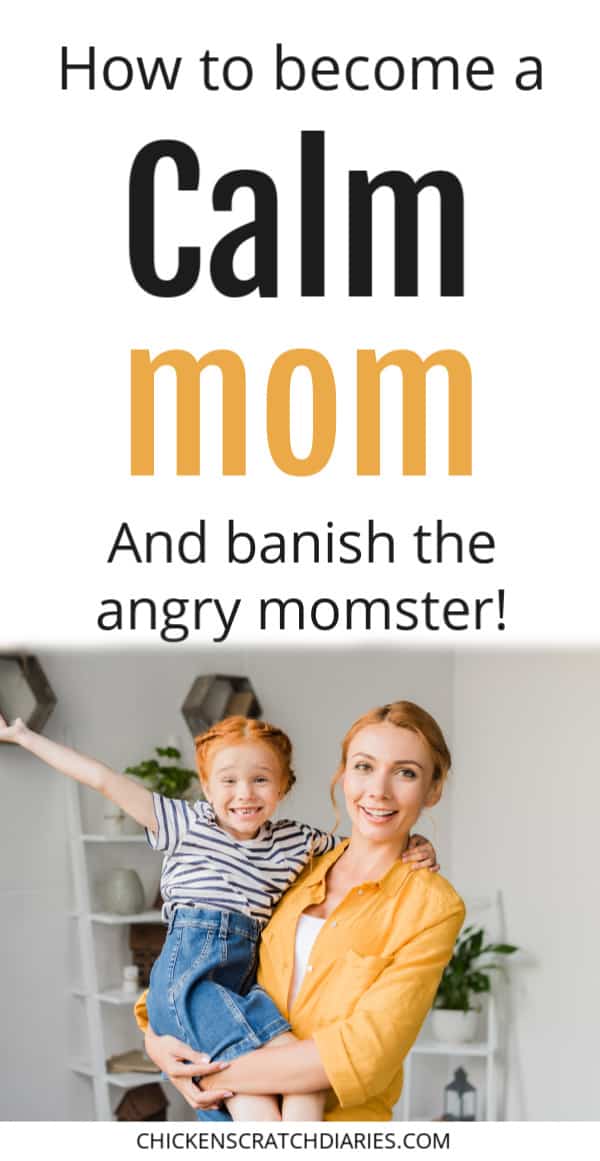Before kids, I had this idyllic vision of what kind of mom I would be.
Patient, kind, selfless, meek and calm would describe the warm fuzzies conjured up by my future-mom-self.
(Cue all the Huggies commercials mixed with a dash of Mother Teresa.)
And I really am that mom – at one point or another.
But unfortunately not all at once. And certainly not all the time.
Thank goodness for God’s grace.
Motherhood-in-reality just doesn’t match up to motherhood-in-my-head, far too often.

This post likely contains affiliate links. Please see our disclosure for more info.
Over time, I’ve had to come to terms with my shortcomings as a mom.
The best thing I can do is to confess them to the Lord and ask for his help, daily.
While I can’t be a perfect mom, one thing I have worked intentionally towards is how to be a calm mom (or a calm-er mom).
Seeing the benefits of a steady, calm voice and a quiet spirit has worked wonders for my perspective —
— not to mention the positive effects on my family.
Getting off the chaos train to chase the calmer path less taken – it’s a daily choice.
But I’m going to share some lessons I’ve learned while inspecting my own heart and internal motivations.
First, there are two phases to this calm-down transformation I think we should identify.
Phase 1: Proactive steps to being calmer mom
Like most of parenting, being prepared is half the battle.
Before my first baby arrived, I spent hours reading up on breastfeeding.
I wanted to know what I was doing so that when I was “in the thick of it” I could recall that helpful information.
Few of us probably spend time as much time (if any) preparing for the emotional toll that parenting can – and will – have on us.
But if I can train myself to know for certain that my patience will be tested 9,487 times a day, I can stop being surprised by it!
Having a plan for handling my kids’ behaviors puts my brain in the driver’s seat before my emotions can take the wheel.

So how do we do this?
First, we examine our mindset and then we learn how to manage our reactions (which we’ll cover shortly).
Believing in the benefits
You probably want to be a calmer mom because you know the effects it has on your kids when you’re not.
Out-of-control and angry isn’t a pretty look on anyone.
So we want what’s best for our kids, but really it boils down to managing our mental, physical and emotional health — and believing it matters.
This means we must be intentional about things like:
- Getting enough sleep
- Eating well
- Managing our time (finding that better balance when we’re struggling)
- Praying and asking for God’s guidance throughout the day
These are simple things that can go a long way towards being consistent, calm and not letting anger control us.
Banish the excuses
It seems that we live in an age where it’s easier to blame our outbursts / lack of self control on others – namely, our kids – instead of owning up to our behavior.
Social media in particular gives us an easy way to vent our frustration and find at least a few people willing to affirm our stances – whatever they might be.
When it comes to how we treat our kids, though, here’s something I’ve come to realize:
It doesn’t matter what the status quo seems to be on Facebook. It doesn’t matter how funny the memes might be about “moms gone crazy”.
My kids deserve my best efforts, and they deserve to be treated with respect.

Childlike, immature and downright annoying behaviors from children?
That’s to be expected.
As adults, we have to let go of our excuses for own bad behavior – regardless of how our children might make us feel at times.
Be honest (really, brutally honest)
Many times I’ve thought unleashing my anger on my kids was just normal and that I needed to “let it out” in order to feel better and move on.
I hate to admit it, but sometimes I can feel a little bit powerful when the unleashed anger * appears * to bring the chaos to a grinding halt.
For a minute or two.
But do I really feel better? No, not when I’m in the right frame of mind.
Not when I come to my senses and God convicts my heart of the ugliness that lies at the root of every outburst.
What anger actually does
I see the timidity of my toddler; the tension in the shoulders of my middle-schooler.
I see my six-year-old scamper into another room to avoid his own tongue-lashing.
I see my chances at raising well-adjusted, emotionally healthy kids slipping away with every loud, ugly word spoken in haste and without regard to anyone else’s feelings but my own.
When I’m honest, I see that my anger is my own issue and it has to be dealt with.
If you’ve landed on this post and been where I’ve been, you know what you’re doing isn’t working.
It’s not gratifying and it’s unhealthy for everyone.
Thankfully, this is where God’s grace reaches down and we’re reminded that today is a new day —
— and He will help us make the changes we need to make.
Phase 2: Managing your reactions
Now that we’ve taken a hard look at the internal motivations and how to adopt the right mindset:
Let’s talk about how to manage our reactions to those things that trigger us.
Because truly, it’s not the fact that we feel angry about certain things.
It’s about how it manifests in our life, and what we decide to do with those feelings.
Naming our triggers
One thing you can do is make a list- mental or on paper – of the circumstances or behaviors that seem to trigger you.

For me, this could be things like:
- When my kids talk back or act disrespectful in some way
- Whining or repeated disobedience
- Being continually interrupted while completing a task or while on the phone
- Sibling fighting / arguing
- Simple mistakes (clogging the sink or forgetting to put their shoes away)
When I look at my list, I can see that nothing on it is surprising.
What I need is a “script” of sorts to help me react the right way.
Go-to statements
How can you know how to respond ahead of time to these triggers? Make a second list. These are your go-to statements.
Before you get ahead of me, I realize these may not necessarily “fix” the issue right away. And you will have to experiment with what works for your personality and your kids’ temperaments.
But having these statements handy will help you shift the focus off your emotions (so you don’t say and do things you will regret).
A few examples:
- Disrespectful behavior
- Go-to statement: “I know we don’t agree right now (or you don’t want to do what I asked, etc.) but I need for you to act respectfully, ok?”
- Whining or repeated disobedience:
- Go-to statement: “It’s time for a little alone time in your room. You can come out when you’re ready to obey / stop whining.”
- Being continually interrupted while completing a task or while on the phone:
- Go-to statement: “I know you have something to say and I will answer you as soon as I’m finished here.” (*Don’t repeat this more than once.)
- Sibling fighting / arguing
- Go-to statement: “I see there’s a problem here. Let’s sit down and talk about it, quietly.” (Or refer to the disobedience statement if it’s gone too far already.)
- Simple mistakes (leaving shoes in the floor, etc)
- Go-to statement: “Please pick up your shoes.” (Or whatever action is needed to teach responsibility fix the problem. If it can’t be fixed, have a conversation or decide what the consequence needs to be.)
What’s most important is to keep your voice low and calm while you stick to your statements.
It’s actually amazing how the whole atmosphere in the room can change when you hold your ground, calmly and firmly.

Related post: How to stop yelling at your kids – and get them to listen the first time
Purposeful actions
Again, I get that even when we say the right things and hold our calm position…
…our kids won’t always obey and sometimes those things that trigger our anger can seem to escalate out of control.
Knowing this is inevitable since we’re all human (kids and parents alike), it’s helpful to make another list of purposeful actions you can take to keep from losing your cool.
Examples:
- Stepping outside and getting fresh air (it works for babies, and sometimes moms too 😉 )
- Redirecting the kids into a new activity or changing the subject (especially helpful with younger ones)
- Going into another room to pray. Ask the Holy Spirit to speak through you when you don’t think you have the words, energy or wisdom you need at the moment.
You can decide what purposeful actions would help you to stay calm in the moment- but make your list before those moments arrive.
Keep them in a note on your phone or somewhere you can refer to easily when you start to see red!
Even after years of practice, I won’t pretend that the momster in me never surfaces from time to time.
But I’m learning that the lasting effects of being a calm mom are worth whatever it takes to get there.
I’ll never be a perfect mom, and you don’t have to be either.
But with God’s help, I can be the mom my kids need me to be, and one I can be proud of, too.
Related Products: Strategies for Defiant Behavior ebook
You might also like:
The Importance of Displaying Grace to our Kids